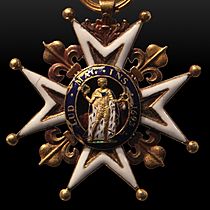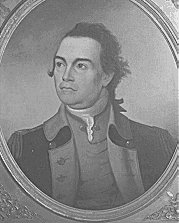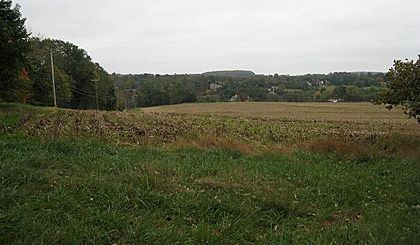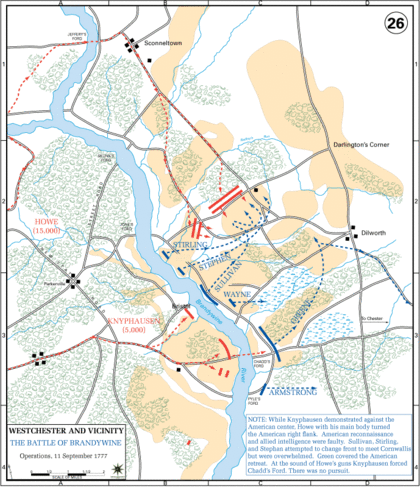Philippe Hubert Preudhomme de Borre facts for kids
Quick facts for kids
Philippe Hubert Chevalier Preudhomme de Borre
|
|
|---|---|
| Born | 17 September 1717 Liège, Prince-Bishopric of Liège |
| Died | 30 May 1789 Brussels |
| Allegiance | |
| Service/ |
Cavalry, artillery |
| Years of service | |
| Rank | |
| Battles/wars | War of the Austrian Succession American Revolutionary War |
| Awards | Order of Saint Louis 1757 |
Philippe Hubert, Chevalier de Preudhomme de Borre (born in Liège on September 17, 1717 – died in Brussels on May 30, 1789) was a French soldier. He joined the French Army in 1740 and fought in the War of the Austrian Succession. Later, during the American Revolutionary War, he traveled to America. He was presented as a military expert and became a general officer in the Continental Army. However, his time as a general was short and not very successful. He resigned and went back to France in 1779.
De Borre started his military career as a volunteer in the French royal army. He served as a cavalry officer in several battles during the War of the Austrian Succession. In 1745, he was badly hurt. In 1757, he created a new army unit from his hometown of Liège (in what is now Belgium). He didn't seem to fight in the Seven Years' War. When he arrived in America in 1776, the Second Continental Congress made him a brigadier general. George Washington put de Borre in charge of the 2nd Maryland Brigade. This unit was part of John Sullivan's division. De Borre led his troops at the Staten Island and Brandywine. At Brandywine, he struggled to lead his soldiers during the fight. He faced a court martial (a military trial) but resigned instead. He left America in 1779. He was promoted to brigadier general in the French army in 1780. However, he was too injured to serve actively anymore.
Early Military Life
Philippe de Borre was born in Liège on September 17, 1717. He joined the Champagne Regiment as a volunteer on May 1, 1740. He quickly moved up in rank. He became a sous lieutenant in 1741 and a lieutenant in 1742. On August 6, 1744, he became a captain in the Duc de Bretagne Dragoon Regiment.
De Borre fought in Bavaria, Bohemia, and Flanders. He was seriously wounded in 1745 while crossing the Rhine River. He got four sword cuts to his head and one to his wrist. The wrist injury permanently damaged one of his hands.
In 1757, while a lieutenant colonel, de Borre formed a new unit. It was called the Liègeois d'Orion Regiment. This unit came from the Prince-Bishopric of Liège. Even though Liège was not part of France, its leader had an agreement with the King of France to provide a regiment. On June 20, 1757, King Louis XV made him a Knight of the Order of Saint Louis. There are no records of him fighting in the Seven Years' War.
In 1762, his regiment was reorganized. He was sent to guard the city of Metz. Until 1767, his job was to stop soldiers from deserting (running away) in the Liège area.
On December 14, 1776, de Borre was a temporary artillery brigadier general. He set out with Philippe Charles Tronson de Coudray and many other French officers. They had the French government's permission to help the American Revolution. Their first ship, the Amphitrite, turned back. So, de Borre and another officer, Thomas-Antoine de Mauduit du Plessis, sailed from Saint-Nazaire on the ship Mercure on February 5, 1777. The ship also secretly carried gunpowder, small weapons, and uniform materials for the American army.
Fighting in the American Revolution
De Borre arrived in America on March 17, 1777, landing at Portsmouth, New Hampshire. He traveled to Morristown, New Jersey. On May 17, George Washington gave him a brigadier general's commission. This rank was officially dated back to December 1, 1776. Washington was organizing the main army into ten brigades at this time.
De Borre was given command of the 2nd Maryland Brigade. William Smallwood led the 1st Maryland Brigade. De Borre's brigade included the 2nd Canadian Regiment, and the 2nd, 4th, and 6th Maryland Regiments.
In May 1777, de Coudray and his group of French officers arrived. Americans were starting to worry about foreign adventurers joining their army. Some foreign officers were helpful, but others were not. For example, Matthias Alexis Roche de Fermoy and Frederick William, Baron de Woedtke were not good generals.
De Coudray had been promised the rank of major general. However, American generals like Henry Knox, Nathanael Greene, and John Sullivan threatened to resign if he was promoted above them. To avoid upsetting France, Congress created a special title for de Coudray. He became the Inspector General of Ordnance and Military Manufactories. This meant he had no power over the fighting generals. De Coudray often argued with other French officers. He even angered Marquis de La Fayette. On September 16, 1777, de Coudray drowned when his horse jumped off a ferry into the Schuylkill River.
On August 22, Sullivan led a raid on British positions near New York City. This was the Battle of Staten Island. The Americans captured most of one loyalist group. However, they lost 20 wounded and 150 prisoners. The British said they captured 260 Americans. Sullivan's officers later accused him of messing up the operation. Sullivan asked de Borre, whose brigade fought in the battle, to stay quiet until his court martial could happen. Sullivan was eventually found innocent.
Battle of Brandywine
On September 11, the British and Hessian army, led by Sir William Howe, fought against Washington's army. This was the Battle of Brandywine. Washington had about 12,000 regular soldiers and 3,000 militia (citizen soldiers).
Sullivan's division, which included de Borre's brigade, was on the right side of the American army. He placed 1,100 troops from de Borre's and Smallwood's brigades at Brinton's Ford. The American scouts were not very good that day. Howe divided his 18,000 British and Hessian troops into two groups. One group, led by Wilhelm von Knyphausen, attacked Chadds Ford directly. The other, stronger group, led by Howe and Lord Charles Cornwallis, marched north.
Around noon, Howe's group crossed the Brandywine at an unguarded spot. They were finally seen by American cavalry. Theodorick Bland quickly told Washington and Sullivan about the danger.
Washington immediately ordered two other divisions, led by Stirling and Stephen, to march north. They had time to get into position on a ridge. At 2:30 PM, Sullivan was ordered to meet up with these two divisions and take command of the right side of the army. He had to move through tough land and connect with other smaller units. During this move, de Borre asked Sullivan if his regiment could rejoin his brigade. Sullivan said no. De Borre was annoyed because this left his brigade with only 350 men.
Sullivan got his men onto a hill. He then realized his division was separated from the other two. Sullivan rode to talk with Stirling and Stephen. Because Smallwood was away, de Borre was left in charge of the two Maryland brigades. De Borre's English was not good, and he was not popular with his officers or soldiers. Sullivan ordered the Maryland division to move to the right to line up with the other two divisions.
Stirling and Stephen moved their divisions without problems. De Borre, however, somehow messed up the move for Sullivan's division. Instead of just moving right, he ordered the division to march to the left and then circle back. After this strange move, the 1st Brigade was almost back where it started. The 2nd Brigade ended up behind the 1st Brigade instead of next to it.
At this moment, the British Guards attacked. When the shooting started, the confused soldiers of the 2nd Brigade accidentally fired into the backs of the 1st Brigade. The 1st Maryland Regiment tried to fight back, but the whole division soon broke apart. The soldiers ran away, chased by the British. De Borre later claimed his cheek injury was from the English firing fish hooks. But others thought he got it from riding through thorny bushes.
Under Sullivan's command, Stirling's and Stephen's divisions fought bravely for an hour. Stirling's group had to retreat first. Finally, Stephen's division was also forced to pull back. Washington saved the army from a total disaster. He brought up George Weedon's brigade to slow down the British chase.
De Borre told Congress that his division ran away without any injuries. He told Washington to move the whole army back to Philadelphia. He also suggested calling up 50,000 militia to bother the British, but this idea was ignored. De Borre was accused of poor leadership. He was told a court of inquiry (an investigation) would be held. He resigned on September 14, and Congress accepted it. The next day, he said he resigned because he led "nothing but bad troops" and refused to be dishonored. However, the 2nd Maryland Brigade was actually made of very good regiments.
Later Life
De Borre left Charleston, South Carolina on January 20, 1779. He carried messages to Charles Hector, comte d'Estaing, whose French fleet was in Cap-François in Haiti. From there, he had an exciting trip back to France on the ship Andromaque (40). On the way, the warship sank a British privateer (a private ship allowed to attack enemy ships) on May 15. He arrived in Brest, France on July 5.
He was promoted to brigadier general in the French royal army on March 1, 1780. But just over a month later, he began the process of retiring due to his physical injuries. He died in Brussels on May 30, 1789. His funeral was on June 1. He wrote a book about his time in America, but it was never published.





